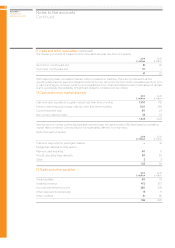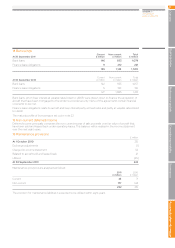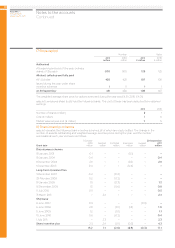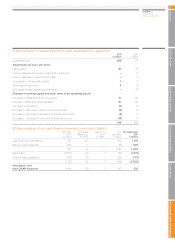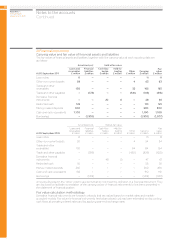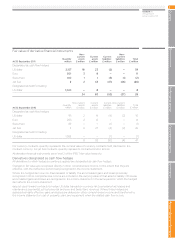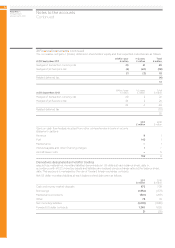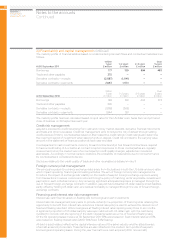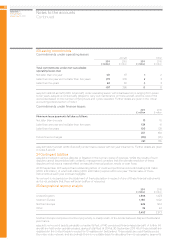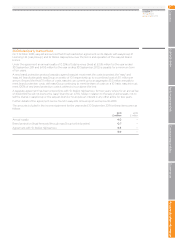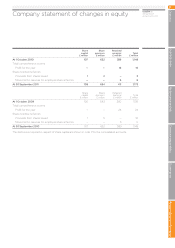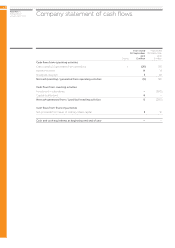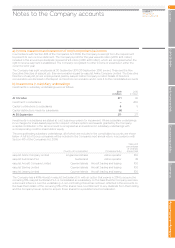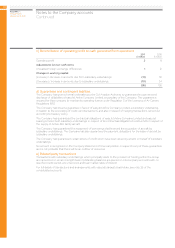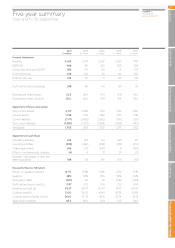EasyJet 2011 Annual Report Download - page 96
Download and view the complete annual report
Please find page 96 of the 2011 EasyJet annual report below. You can navigate through the pages in the report by either clicking on the pages listed below, or by using the keyword search tool below to find specific information within the annual report.
Notes to the accounts
Continued
22 Financial risk and capital management continued
The maturity profile of financial liabilities based on undiscounted gross cash flows and contractual maturities is as
follows:
At 30 September 2011
Within
1 year
£ million
1–2 years
£ million
2–5 years
£ million
Over
5 years
£ million
Borrowings 177 169 584 493
Trade and other payables 375 – – –
Derivative contracts – receipts (2,887) (1,041) – –
Derivative contracts – payments 2,843 1,031 – –
At 30 September 2010
Within
1 year
£ million
1–2 years
£ million
2–5 years
£ million
Over
5 years
£ million
Borrowings 148 159 444 573
Trade and other payables 399 – – –
Derivative contracts – receipts (1,838) (369) – –
Derivative contracts – payments 1,844 391 – –
The maturity profile has been calculated based on spot rates for the US dollar, euro, Swiss franc and jet fuel at
close of business on 30 September each year.
Credit risk management
easyJet is exposed to credit risk arising from cash and money market deposits, derivative financial instruments
and trade and other receivables. Credit risk management aims to reduce the risk of default through setting
credit exposure limits to counterparties based on their respective credit ratings. Credit ratings also determine
the maximum period of investment when placing funds on deposit. Credit risk is limited to the carrying value
amount in the statement of financial position at each year end date.
Counterparties for cash investments, currency forward contracts and jet fuel forward contracts are required
to have a credit rating of A or better at contract inception. Exposures to those counterparties are regularly
reviewed and, when the market view of a counterparty’s credit quality changes, adjusted as considered
appropriate. Accordingly in normal market conditions, the probability of material loss due to non-performance
by counterparties is considered to be low.
Disclosure relating to the credit quality of trade and other receivables is detailed in note 11.
Foreign currency risk management
The principal exposure to currency exchange rates arises from fluctuations in both the US dollar and euro rates
which impact operating, financing and investing activities. The aim of foreign currency risk management is
to reduce the impact of exchange rate volatility on the results of easyJet. Foreign exchange exposure arising
from transactions in various currencies is reduced through a policy of matching, as far as possible, receipts and
payments in each individual currency. Any remaining significant anticipated exposure is managed through the
use of forward foreign exchange contracts. In addition, easyJet has substantial US dollar balance sheet liabilities,
partly offset by holding US dollar cash; any residual net liability is managed through the use of forward foreign
exchange contracts.
Financing and interest rate risk management
Interest rate cash flow risk arises on floating rate borrowings and cash investments.
Interest rate risk management policy aims to provide certainty in a proportion of financing while retaining the
opportunity to benefit from interest rate reductions. Interest rate policy is used to achieve the desired mix of
fixed and floating rate debt. All borrowings are at floating interest rates repricing every three to six months.
A significant proportion of US dollar loans by value are matched with US dollar cash, with the cash being
invested to coincide with the repricing of the debt. Operating leases are a mix of fixed and floating rates.
Of the 64 operating leases in place at 30 September 2011, 69% were based on fixed interest rates and 31%
were based on floating interest rates (2010: 66% fixed, 34% floating).
All debt is asset related, reflecting the capital intensive nature of the airline industry and the attractiveness
of aircraft as security to lenders. These factors are also reflected in the medium term profile of easyJet’s
borrowings and operating leases. During the year 11 aircraft were cash acquired (2010: nine aircraft).
94
easyJet plc
Annual report
and accounts 2011


